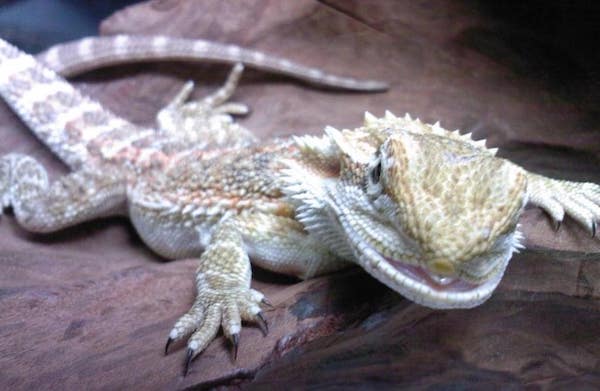While bearded dragons are naturally pretty hardy, that isn’t to say that they can’t develop serious health issues! In fact, in this article alone we will be discussing 17 bearded dragon diseases, health concerns, and illnesses that all owners should be aware of!
One reason it’s important to be educated on bearded dragon health concerns, is because your beardie will hide symptoms.
In the wild, bearded dragons are programed via natural selection to try and camouflage any weakness. This reduces their chances of being seen as easy pickings for a predator.
Because of this, don’t be surprised if you notice your obviously sick bearded dragon trying to act normal.
In This Article
Bearded Dragon Diseases, Health Concerns, & Illnesses… What’re the Differences?
Before diving into the specific diseases, health concerns, and illnesses, it is first important that we take a moment to briefly discuss the differences between the three…
Understanding the differences will help you in understanding the severity of each condition and also how much concern you should have, as well as how quickly to take action.
First, let’s briefly discusses disease. A disease is an abnormal condition in which an underlying, diagnosable issue affects a part or structure in part or all of an organism.
Diseases are the specific root of an illness and health concern. They’re in essence, the underlying issue so-to-speak.
Some diseases will be curable, whereas others will not. Often times with reptiles, the swiftness in which a disease is diagnosed and treated plays a HUGE role in determining whether or not the reptile can overcome it.
This is why I consider the 6 listed diseases to be of the MOST time sensitive and serious conditions of all!
Next, we have illnesses. Illnesses are defined as physical symptoms, sometimes broad, used to describe the condition the organism is in. Illnesses can be physical symptoms of an underlying disease or exist temporarily due to something less serious.
An example of an illness for a person would be that of allergies or a common cold.
Lastly, I’ve decided to include the category “health concerns” to describe physical abnormalities in behavior and appearance that may or may not initially have an obvious explanation or raise much concern.
Think of a health concern as a minor concern or curiosity that may be representative (or not) or a bigger problem.
For instance, a health concern for a person may be random bruises popping up, abnormal hair loss, or irregular sleeping patterns.
Health concerns are absolutely worthy of paying attention to and addressing, but when presented singularly… should not typically be too worrisome.
I’ve organized this post in a type of hierarchy, with the more serious diseases up top, followed by illnesses, and the least serious health conditions.
It is important you realize that there could overlap between the 3 categories as well as zero overlap between them…
For instance, your bearded dragon could have Metabolic Bone Disease (disease) AND be exhibiting both paralysis (illness) AND lethargy (health concern).
Additionally, your bearded dragon could be exhibiting lethargy simply because you kept them up all night by leaving a light on.
The post is organized in a hierarchy, with the most pressing issues (the diseases) being grouped higher. As you work your way down the post, the conditions presented will (typically) decrease in sensitivity, urgency, and level of concern.
With that being said, let’s jump into discussing all of the most common bearded dragon diseases, health concerns, and illnesses!
5 Common Bearded Dragon Diseases
Metabolic Bone Disease
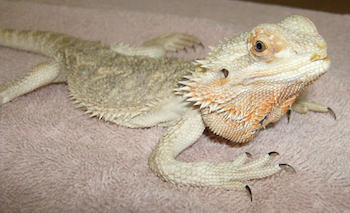
Metabolic Bone Disease or MBD as it is commonly referred to, is unfortunately very common amongst bearded dragons.
This disease occurs when…
- bearded dragons either aren’t absorbing calcium properly OR
- aren’t receiving enough to begin with.
This horribly debilitating disease deteriorates a bearded dragon’s bones and can actually be life threatening if left untreated.
Fortunately, if caught early on, you can essentially reverse MBD… although you will never be able to fully get rid of it.
Knowing what to look for and being able to develop a thorough plan of action can make the difference between your bearded dragon living a painful and deformed life or a relatively normal and happy one.
Being able to recognize the symptoms of MBD right away is CRUCIAL to keeping your bearded dragon healthy. This common diseases is not to be slept on as it is swift acting and deadly.
Yellow Fungus
Scientifically referred to as Chrysosporium Anamorph of Nanniziopsis vriesii (CANV), Yellow Fungus is a rather aggressive fungal infection that attacks a bearded dragon’s superficial and deep tissues, as well as their organs in severe cases.
As you might suspect, Yellow Fungus discolors a bearded dragon’s scales, making them appear yellow. As the scales become discolored, they can actually break off and reveal raw and extremely sensitive tissue.
And while many owners are divided over whether you can actually cure Yellow Fungus or not, one thing is for certain…
Early detection is key to keeping this nasty diseases under control and improving your beardie’s quality of life.
If you act fast, your chances of getting the infection under control will improve dramatically. I can’t stress this enough!
Upper Respiratory Infection
Commonly referred to as a URI for short, Upper Respiratory Infections are a bacterial infection of the lungs that typically occurs in bearded dragons from an abundance of moisture.
A bearded dragon with a URI, will typically display the following signs…
- Breathing with an open mouth
- Gasping for air
- Slimy, mucus-like discharge coming out of the mouth/nose
In my experience, I have found URIs not only pretty easy to prevent, but also cure as well. Fortunately, there are many things you can do to ensure your bearded dragon isn’t at risk of a URI.
Parasites
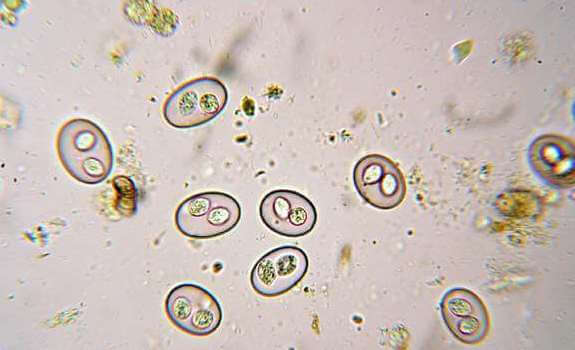
While all bearded dragons have parasites in their system to some extent, those who suffer from a high parasite count will become sick and weak.
You see, parasites live within other creatures (hosts), who they derive their sustenance from.
If the body has a high parasite count…
then that means it may be being robbed of nutrients and/or blood, which can lead to sickness, a weak immune system, and more.
Unlike wild bearded dragons, those that are captive tend to be much more prone to a high parasite count. This is largely in part to them being confined to a tank that could be inadequate or filthy.
Here’s a look at some of the more popular parasites found in bearded dragons…
Bearded dragons that have a high parasite count can display such symptoms as diarrhea, vomiting, a lack of appetite, and even lethargy and weight loss.
If you suspect your bearded dragon is dealing with a high parasite count, then you’ll want to bag up any vomit or stool to take into the vet for a test.
The vet will be able to test the waste and determine if parasites are in fact a culprit in your beardie’s poor health. From there, antibiotics will be prescribed and injections may also be given as well.
Cancer
Obviously one of the more alarming bearded dragon diseases on this list, cancer is unfortunately something your beardie can suffer from, especially later on in life.
Often times, cancer in bearded dragons is hard to detect in the beginning, just like with most creatures. Try and pay attention to your bearded dragon’s weight and appetite, as well as their energy levels.
And don’t be afraid to regularly feel for lumps and abnormalities that may signal a tumor, especially in the chest and stomach.
Should you suspect your bearded dragon has a tumor or is getting sick, be sure to take them into the vet ASAP.
Your vet will be able to perform an X-ray to determine if there is in fact a mass within your bearded dragon and how big it is. From there, surgery may be recommended as a means to remove the growth.
Another thing to understand about bearded dragon cancer is that because there is A LOT of inbreeding of bearded dragons right now in the U.S. marketplace, the chances of your bearded dragon getting sick are pretty good should you buy from the wrong person.
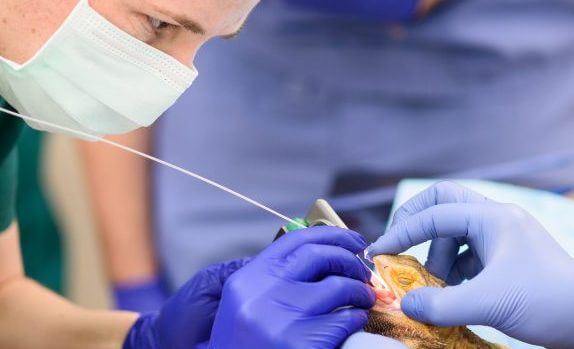
Because of this, I cannot recommend enough that you do your homework and find a responsible and loving breeder who has a LONG history of breeding reptiles not so much as a primary source of income, but a passion.
These are the people who will breed only health dragons and make sure to diversify the bloodlines to produce healthy offspring.
When looking at the babies or speaking with them, don’t be afraid to ask them a lot of questions to really get a feel for them as a person, as well as their knowledge on the mom and dad.
6 Common Bearded Dragon Illnesses
The following 6 bearded dragon illnesses are relatively common and can affect even healthy beardies at some point in their life. Although typically less serious than the aforementioned diseases, you’ll want to be hyper aware of these illnesses before adoption and while raising your beardie since early detection is key!
Mouth Rot
Medically referred to as Infectious Stomatitis, Mouth Rot is essentially when the inside of your bearded dragon’s mouth becomes inflamed to the point of tissues actually rotting.
It is the physical representation or symptom of typically an underlying bacterial, fungal, or viral infection.
So, how does this actually happen? Well, it could be due to a variety of reasons really. However, more often than not… Mouth Rot occurs when the bearded dragon’s immune system has been compromised, making it easier for them to suffer from infection.
Your bearded dragon’s immune system can be weakened from…
- Inadequate cage temps and humidity levels. When your bearded dragon lives in an environment where the temperatures aren’t ideal, their immune system can actually be comprised, making it much easier for them to suffer from infections.
- A poor diet. When your bearded dragon isn’t getting the proper nutrients their bodies, much like that of people, can become sickly and weak. This is the perfect condition for an infection, that may have otherwise been fought off, to flourish in.
- Stress. Stress is the culprit behind many a health issue, but it is often times especially responsible for Mouth Rot. When your beardie is stressed, they will have a more difficult time fighting off fungi and bacteria that are breeding in their mouth.
As far as symptoms, bearded dragon with mouth rot will typically display some or all of the following symptoms…
- Decreased appetite/disinterest in food
- Inflamed or red oral tissues
- Yellowish or grayish areas of skin around mouth
- Excessive saliva or discharge from the mouth
- Dead tissue in or around the mouth
- Swelling of the head (common in severe cases)
Mouth rot is NOTHING to mess around with, as if left to run it’s course, the infection can spread to other areas of your beardie’s body.
Fortunately, it’s pretty easy to catch mouth rot early on if you simply make it a habit of keeping an eye on the appearance of your bearded dragon’s mouth.
Early diagnosis can mean the difference between a speedy and low-cost recovery, or a long, drawn-out, and expensive treatment.
If you suspect your bearded dragon has mouth rot, you’ll want to make an appointment with a herp vet right away who will perform a physical exam of your pet’s mouth.
If a diagnosis of Mouth Rot is made, you can expect the vet to…
- Prescribe antibiotics
- Flush the dragon’s mouth with an antiseptic
- Potentially administer some injections
In more severe cases, surgery may be required to remove tissue that is especially rotten or dead.
Additionally, your vet may want to remove plaque buildup from the teeth and gums as well.
Paralysis
Most often associated with Metabolic Bone Disease, paralysis can actually occur for a variety of reasons…
Whether it’s a lack of calcium weakening the bones such as in Metabolic Bone Disease OR serious impaction, you’ll want to get to the bottom of this issue stat!
Paralysis is one of the more concerning bearded dragon illnesses you can encounter as it is always indicative of a bigger problem.
As such, if you notice your bearded dragon having difficulty moving or dragging their limbs, I recommend making an appointment with a herp vet ASAP.
If your dragon is dragging their limbs or positioning them in a weird way, I would jump into action immediately before this issue progresses.
To determine if your bearded dragon is suffering from paralysis, try touching the limb or body part in question and seeing how they respond.
If they don’t move it, chances are that body part could be suffering from paralysis.
Impaction
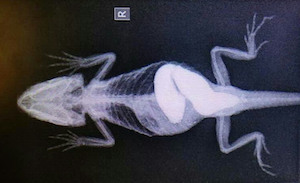
Quite possibly the most common bearded dragon illness to be on the lookout for is impaction.
Impaction occurs when there is an internal blockage that prevents your bearded dragon from having a bowel movement.
Here’s how impaction can happen…
- Giving feeders larger than the space between a bearded dragon’s eyes
- Using loose particle substrate
- Improper temperatures
Bearded dragons that are impacted will often times…
- Stop going to the bathroom
- Stop using their hind legs
- Stop eating
If you see this, know that the impaction is very severe and that you should take your bearded dragon to the vet ASAP!
Fortunately, there are things you can do to both prevent and even cure impaction in most cases! Knowing these measures may just save your bearded dragon’s life.
Retained Shed
A retained shed, which is medically referred to as Dysecdysis, is when the outer layer of a reptile’s skin fails to shed in a normal manner.
If your bearded dragon has areas that are demonstrating a retained shed, you should notice a dead and dull appearance of the skin.
The main areas to look out for are those that can lose circulation easily, such as toes, limbs, and the tail.
When these parts of the body retain a shed, it can lead to problems over time due to a lack of blood flow. In extreme cases, these parts of the body can even rot away.
If you suspect your bearded dragon is demonstrating a retained shed, try applying some cocoa butter or aloe vera to the area once or twice daily.
You should only be super concerned about retained shed IF…
- There’s a retained shed on the body parts mentioned above
- Your bearded dragon is losing circulation
Now with all of this being said, you can still do things to help your bearded dragon have a healthy and problem-free shed, so just make sure you read up on those tips.
Tail Rot
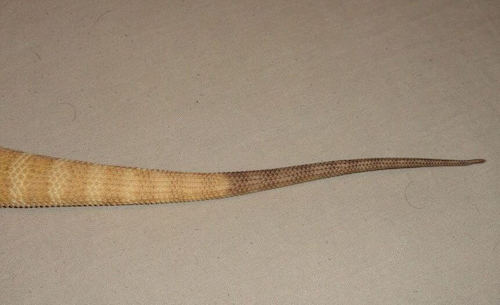
Like the name suggests, tail rot is a condition in which your bearded dragon’s tail actually begins to rot. It is caused by an internal infection that can lead to serious damage if left unattended.
From the tail falling off to organ failure, tail rot can have devastating consequences for your bearded dragon, which is why it is SO important you know the warning signs!
Being able to quickly identify tail rot is helpful in that it allows you to not only salvage as much of the tail as possible, but keep your dragon in as little pain and discomfort as possible.
Often times if caught early on, you can cure the infection with antibiotics or home remedies without having to amputate any of the tail.
So, how exactly does tail rot happen? Here are the most common culprits behind this issue…
- Poor husbandry conditions. Specifically, we’re talking about insufficient UVB exposure. If your bearded dragon doesn’t get enough UVB, then they can’t probably absorb vitamin D3 from calcium. This can cause their bones to weaken as they rob the rest of the body of calcium.
- Insufficient calcium. Without adequate levels of calcium, it should come as no surprise that Additionally, if your bearded dragon doesn‘t receive enough calcium to begin with, they can also suffer from tail rot.
- A tail injury. Whether bitten by another animal, crushed under something heavy that topples in their enclosure, or pinched, the tail can begin to rot away when severely injured.
When dealing with tail rot, it is always important to try and take your bearded dragon into the vet ASAP.
However, if this is not an option or you have to wait a while to be seen, there are at home remedies you can practice to help kill the infection and save your dragon’s tail… or at least as much of it as possible.
Diarrhea
Although bearded dragon poop would NEVER be compared to a bouquet of roses… bearded dragon diarrhea is on a whole other level of stink!
Capable of completely fumigating your entire home, bearded dragon diarrhea can occur for a variety of reasons, some small some big.
Now, you’ll want to make sure your bearded dragon is ACTUALLY having diarrhea before freaking out. It isn’t uncommon for owners to think their bearded dragons are having diarrhea when they’re actually not.
Typically, you can chalk bearded dragon diarrhea up to one of the following reasons…
- Imbalanced diet. Have they indulged in too many dark leafy greens or fruits? Could they have eaten something they weren’t supposed to?
- Dirty water. Or is your tap water especially high in chemicals such as chlorine or heavy metals? If so, consider treating it with a reptile water conditioner before giving it to your bearded dragon.
- Stress. Before a big event or during times of stress your stomach is likely not exactly feeling its best, right? Likewise, bearded dragons too can frequent the “restroom” and experience abnormal stool during times of high stress.
- Parasites. Parasites can not only cause your beardie’s stool to be runny and smelly, but can also present other issues. Every bearded dragon will most likely have parasites in their gut to some extent. However, those who come in contact with aggressive parasites might not be able to keep their levels down.
Suspect your bearded dragon could be having diarrhea due to parasites? If so, your BEST bet is going to be to collect their stool in a Ziploc and take them into the vet for a fecal test. Try to bag a sample as close to the vet appointment as possible.
In terms of helping to calm their upset stomach, I recommend giving your bearded dragon foods that are gentle. Perhaps you should even remove solid food all together until things are back to normal.
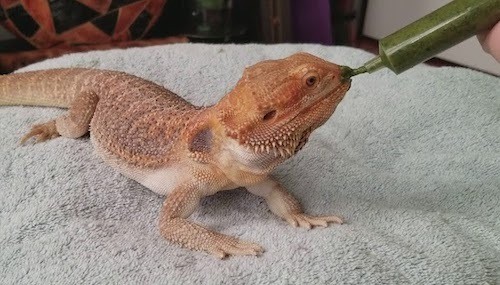
Bearded dragons who have diarrhea can be fed…
- Slurries. Try making them a slurry to ensure they’re still getting all their essential nutrients.
- Sweet potato or chicken baby food via a syringe. This method is especially helpful if they’re refusing to eat/you don’t have time to make a slurry.
Also, consider giving your bearded dragon a bath to prevent them from becoming dehydrated if the problem persists. You can also mist them with water or drop some droplets on their snout if they’re highly opposed to baths.
Throwing Up
As any worried pet parent would be, you’re naturally going to be a little distraught at the site of your beloved beardie blowing chunks.
I mean, let’s face it… throwing up is painful and seriously awful no matter why or who it’s happening to!
And although your beardie might never throw up, it’s still important to be able to distinguish between poo and vomit.
Throwing up is by no means a “normal” behavior and as such, should command immediate attention.
One key difference between poo and vomit is the…
Relative “neatness” of the pile itself. Is the waste sitting neatly in one location? If so, it’s likely poo. Or… is the waste strewn about messily? If so, you’re most likely dealing with vomit.
If you’re dealing with vomit, IMMEDIATELY try and get to the bottom of why your beardie got sick.
Reasons for throwing up are far and wide, so you may need to do some of your BEST detective work to get to the bottom of things.
Also, I highly recommend storing the vomit in Tupperware or a ziploc bag and placing it in the fridge for the vet.
It’s gross, yes, but really helpful to bring in for the vet to run tests on if you’re unable to figure out why your beardie is sick.
5 Common Bearded Dragon Health Concerns
The following bearded dragon health concerns are things all owners should be keen to observe, as they most often indicate a bigger problem is at play. Should you notice these health concerns at their onset, it is likely you’ll be able to get your bearded dragon back to normal in no time!
Sunken Eyes
Do your bearded dragon’s eyes look sunken in? If so, they’re most likely dehydrated!
Try giving them a bath or putting some drops of water on their nose with a dropper.
You can also make them a mixture of Powerade and water at a 1:1 ratio to give their thirsty body some much-needed electrolytes.
Wrinkly Skin
Unlike humans who acquire wrinkly skin as they age, a bearded dragon’s wrinkly skin has nothing to do with age and everything to do with weight and hydration.
Beardies with wrinkly skin can be underweight, dehydrated, or both!
Now, a little bit of wrinkly skin is hardly a cause for concern. But a lot? That/’s when you’ll want to take action!
But, how do you know if they have enough wrinkly skin to cause concern?
Try gently pinching an area of skin that looks loose. If it doesn’t immediately settle back into place and smooth out once you release, this is when you might have a problem.
Bearded dragons that are dehydrated should be given a soak in the tub for 15-20 minutes, with water below the shoulders but deep enough to cover their vent.
If you suspect your bearded dragon is underweight, then you’ll want to take some time to discover all the helpful ways you can fatten them up and get them to eat!
Lethargy
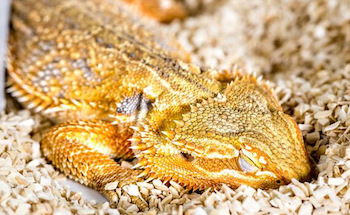
If your bearded dragon is exhibiting lethargic behavior, it could be due to a variety of reasons…
- It’s Fall/Winter. It could be, that your bearded dragon is simply getting ready to brumate, which is essentially the reptile version if hibernation. If they’ve recently come out of brumation, they can also remain a little lethargic for days or weeks.
- Poor husbandry. It could also be that their tank setup is wrong. Inadequate temperatures can caused not only lethargy, but a lack of appetite as well.
As a reminder, you should have a temperature gradient within the tank, with a hot and cool side.
For adults, aim to have the hot topping out at 95-100 degrees Fahrenheit. For juveniles and babies, keep it a little hotter at 105-110 degrees Fahrenheit. When it comes to the cool side, try to keep it between 80 and 85 degrees Fahrenheit regardless of age.
Lack of Appetite
Unfortunately, a lack of appetite in your bearded dragon could be due to many different things.
However, it is important to remember that bearded dragons can be picky eaters at times.
If you’ve switched your dragon to a different diet recently, chances are they’re just being picky! However, if your bearded dragon’s diet hasn’t changed recently, then their suppressed appetite is likely due to something else.
Here are some reasons your bearded dragon may have a lack of appetite…
- Brumation
- They’re sick
- Inadequate cage temps
- Impaction
- Improper lighting setup
- Lack of variety
- Parasites
- Stress
- Mouth rot
Now, of course these are not the ONLY reasons why a bearded dragon might stop eating. However, they are what I consider to be the most common culprits. Along with them just being picky of course.
Naturally, you’re going to want to do what you can to get your bearded dragon eating again. Understanding the reason for their lack of appetite first is essential.
In combatting a lack of appetite, it is also important to know how long a bearded dragon can go without food. Should they go too long, there’s definitely measures you’ll need to take to get food in their system right away!
Sunken Fat Pads
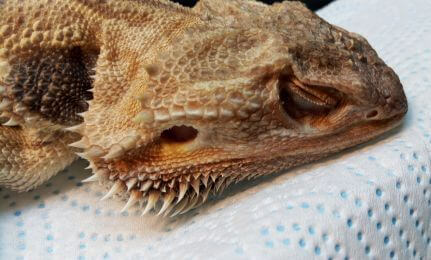
Fat pads are the typically soft and squishy area behind the eyes where a bearded dragon stores extra fat. When they’re sunken it’s most commonly an induction that your bearded dragon is underweight.
To locate fat pads, simply look behind each of your bearded dragon’s eyes. From there, you should see two small raised areas of soft skin.
Healthy dragons will have fat pads that are noticeably raised. On the flip side, unhealthy dragons can have fat pads that are sunken in or virtually flat.
Fat pads that are sunken in should be your first indication that your dragon is either malnourished or dehydrated.
Wrapping Up Bearded Dragon Diseases, Health Concerns, and Illnesses
Although this list may feel and look overwhelming, I want you to remember one thing…
This is by no means an overview of EVERY issue you can expect to encounter with a bearded drag on! Additional ones may be diseases like the fatal atadenovirus or adenovirus.
It is extremely unlikely that you’ll have to deal with the majority of concerns this list!
However, the point is to simply give you an idea of common diseases, health concerns, and illnesses.
You should always be prepared before adopting a new pet by knowing what you’re getting into.
If you feel that your bearded dragon is suffering from any of the aforementioned health issues, I cannot encourage you enough to read up on the specific health issue more, especially if there’s a link for a more detailed article.
Here is our article about the bearded dragon’s hemipenis and how to approach issues around the area of the male reproductive organs.
Education is one of your best bets when it comes to keeping your bearded dragon healthy and these articles exist for a reason!
The bottom line? If you do your due diligence as a pet owner, then your bearded dragon will live a long and healthy life.
